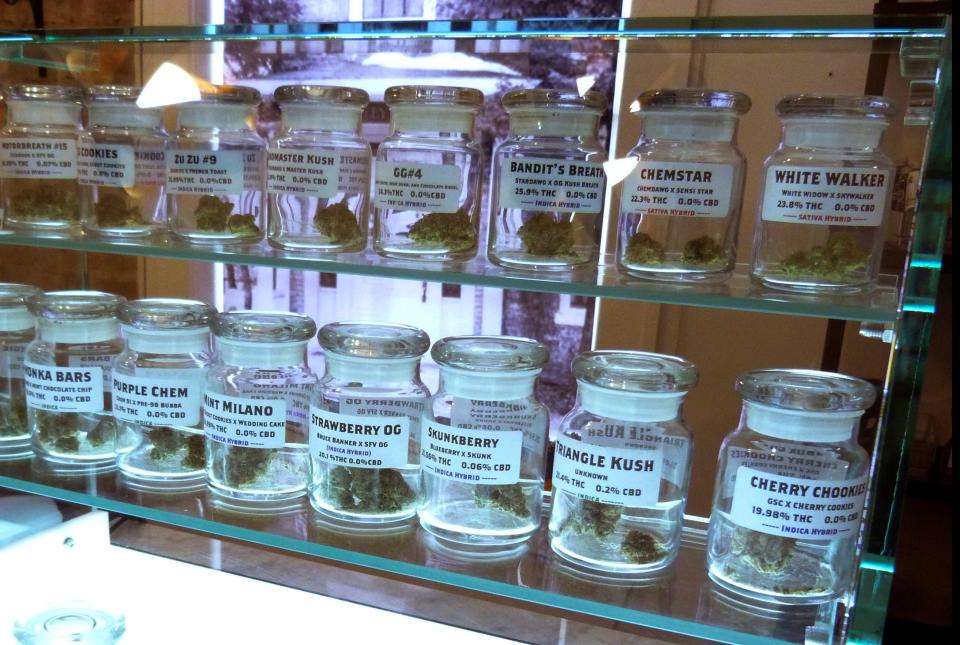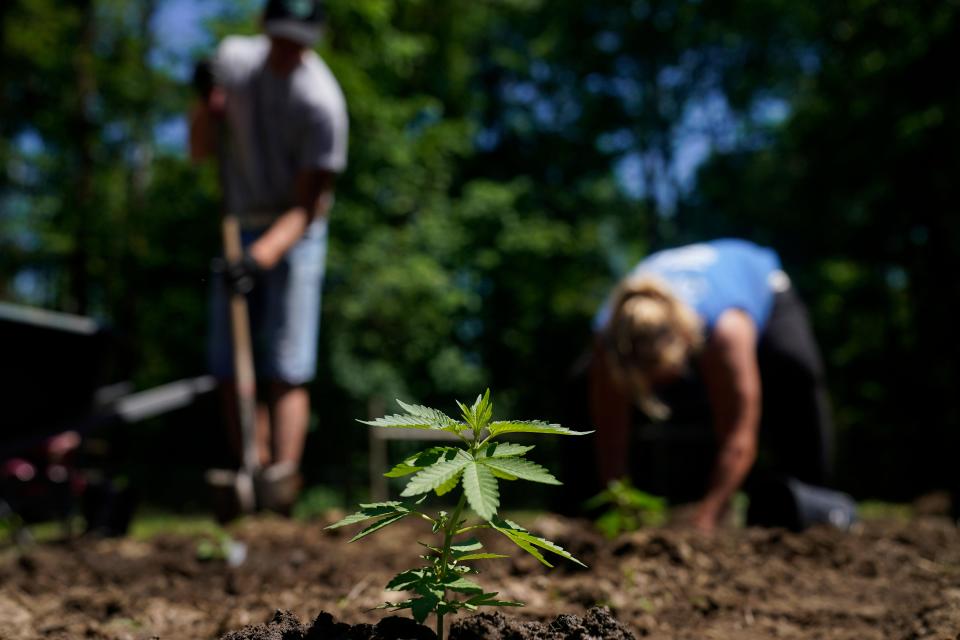Time for change: Federal ban on marijuana use causes more harm than good

A decade ago, Americans were nearly evenly split on whether to legalize marijuana. While half the country favored revising U.S. drug laws to make room for legal pot, the other half said to keep cannabis prohibition in place.
Public opinion has since shifted dramatically. Now more than two-thirds of the country favors legalization. That includes 83% of Democrats, 71% of independents and 50% of Republicans, according to Gallup polling.
But just because a proposal is popular doesn’t mean it is wise.
Like you, we on the USA TODAY Editorial Board have seen and felt the national sentiment shift in recent years, and we have asked whether this direction is in the country’s best interests. With editorials in 2012, 2016 and 2018, we urged caution, worrying that a rush to legalize marijuana could carry consequences both unintended and unwelcome.
Biden takes action: USA TODAY Opinion urged reform of marijuana laws. Biden's pardons are a good first step.
Now that Democrats in the Senate have introduced a package of proposed marijuana policy reforms – along with a commitment to work with Republicans “to get something done this year” – it’s time we look back on what we have learned in recent years and rethink our position.
You’re reading Our View: It's time to legalize weed
For other views, read: Marijuana risks show why decriminalization is needed
How big will legal weed get? Two factors limit market size, even if US legalizes cannabis.
More and more states contradict federal cannabis law
A decade ago, none of the 50 states had legalized marijuana for recreational use. That began to change in late 2012, when Colorado and Washington authorized their “adult use” programs. Now a majority of states have laws that permit marijuana in certain circumstances:
?Nineteen states allow marijuana for medical or recreational use.
?Eighteen states allow marijuana for medical purposes only.
?10 more states allow products with nonpsychoactive compounds.
?Two U.S. territories and Washington, D.C., also have legalized recreational marijuana.
Three states – Idaho, Kansas and Nebraska – do not allow any marijuana products.

Despite these state laws, cannabis possession is still a federal crime. As far as federal law is concerned, buying marijuana in a state-authorized storefront is just as illegal as purchasing it from a drug dealer.
No compromise on abortion?: Extremist views undermine their cause
Federal law enforcement policies are, of course, another matter. The Justice Department has generally taken a hands-off approach in recent years related to state-legal marijuana operations. But that highlights the glaring contradictions in U.S. drug policy.
Supreme Court Justice Clarence Thomas has called the federal government’s approach “a half-in, half-out regime that simultaneously tolerates and forbids local use of marijuana,” resulting in an “unstable state of affairs” that “strains basic principles of federalism and conceals traps for the unwary.”
The consequences for the lives and livelihoods of the American people have become too widespread and absurd to ignore.
Russia needs to release Brittney Griner. And US leaders need to fix our cannabis laws.
Latest evidence shows marijuana can be useful, but also harmful
Our editorial in 2018 noted concerns that legalizing marijuana could lead to higher rates of use among teenagers and children. But data from Colorado and Washington, where recreational pot sales began in 2014, indicates this didn’t happen.
?The biennial Healthy Kids Colorado Survey found that reported rates of marijuana use among high school students held relatively steady, fluctuating between 19% and 22% from 2005 through 2019, keeping roughly in line with the national average. (That figure dropped significantly to just 13.3% for Colorado teens in 2021, during the COVID-19 pandemic.)
?The biennial Washington State Healthy Youth Survey similarly found “no significant trends” over time in reported marijuana use among students in middle school and high school from 2006 through 2018, which means legalization didn’t lead to a spike in teen marijuana use there, either.
US must investigate: Was Palestinian American journalist killed by Israeli soldiers?
?Even so, other researchers warn that preexisting downward trends in marijuana use among teens could be masking the detrimental effects of legalization. Regardless of whether Congress legalizes marijuana federally, policymakers must keep a careful eye on the evolving body of research. Marijuana isn’t harmless, especially for young people.

While legalization proponents might have overhyped the medicinal benefits of cannabis, there is ample evidence that the drug could be useful in soothing chronic pain and other symptoms of certain ailments, so it makes no sense for marijuana to still be listed as a Schedule 1 drug under federal law.
Legalizing cannabis at the state level has spurred impressive business growth with direct and indirect benefits. At the same time, the idea that legal cannabis will supplant illegal sales hasn’t always panned out. In California, where voters used a ballot initiative in 2016 to legalize personal use and cultivation, the illicit market is still bigger than the legal market. High taxes and bureaucracy seem to be to blame.
What are they smoking?: Analysts cite inflated projections for legal weed market
Ramifications of cannabis prohibition
No serious conversation about marijuana legalization can ignore the key role prohibition has played in the war on drugs, which has disproportionately harmed Black and Indigenous Americans and other people of color, and continues to do so:
?Black people are significantly more likely than white people to be locked up for drugs, even though Black and white Americans sell and use drugs at similar rates.
?Hundreds of thousands of marijuana arrests have been carried out in each of the past 50 years, often pulling people out of their communities and complicating their ability to find work, housing and other opportunities.
?Those who have been penalized for cannabis crimes are disproportionately Black and brown, while those who have capitalized on legalized pot are overwhelmingly white.
The strongest argument for Congress to end federal marijuana prohibition finds its roots in the far reaching harms and disparities that stem from its criminalization. The nation’s misguided war on drugs will continue inflicting harm until cannabis is decriminalized.
Nonetheless, decriminalization alone is not enough. Given the risks associated with marijuana, the nation needs the federal government to shift its posture from prohibition to regulation. To make that shift effectively, Congress needs to take a hands-on approach.
That requires legalization.
More from Our View
?Bad cops deserve to be exposed: Police must stop dodging information requests
?Congress must save endangered species: Local newsrooms are shrinking or disappearing, hurting democracy
?How to help stop more school shootings?: Raise the age to buy a rifle to 21
USA TODAY's editorial opinions are decided by its Editorial Board, separate from the news staff and the USA TODAY Network. Most editorials are coupled with an Opposing View, a unique USA TODAY feature.
To read more editorials, go to the Opinion front page or sign up for the daily Opinion email newsletter. To respond to this editorial, submit a comment to [email protected].
This article originally appeared on USA TODAY: Federal marijuana prohibition is harmful, it's time to legalize weed